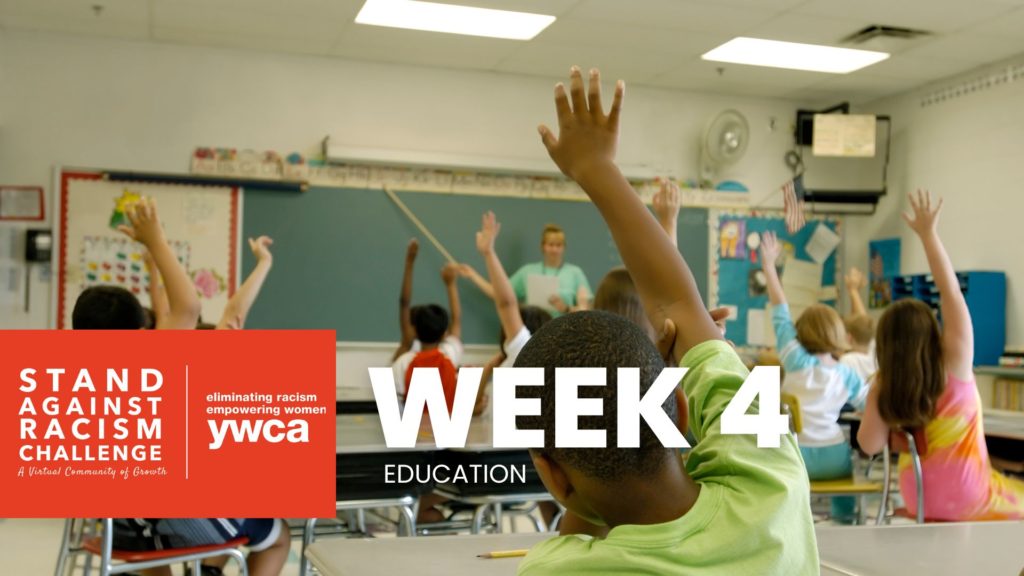
Day 16: School Segregation
Welcome to the last week of the Stand Against Racism Challenge. This week we will discuss the history and impact of inequalities within our education systems. Over 65 years ago, the landmark ruling in the Brown vs. Board of Education Supreme Court case declared racial segregation unconstitutional, yet today we see our schools just as segregated, if not more than in 1954. The results of this continued segregation has perpetuated a lasting negative effect on children and communities of color. Today we will explore that history and its continued and renewed impact on our education system.
Watch this video
on how modern day segregation impacts the quality of education in one Louisiana school district
(8 minutes)
Read this article
for a history of school segregation from the 1890s to the present
(10 minutes)
Watch this video
of Kandice Sumner talking about her experience with school segregation and what she’s doing to give her students a better chance
(14 minutes)
Day 17: What We Teach
If you’ve ever changed schools in the middle of the year, you may be able to recall minor differences in curriculum between districts. However, imagine moving from a predominantly white high school in Texas, to a more diverse school in California. You may not think much about the vast ways in which the exact same material can vary depending on a pupil’s school, school district and instructional materials. Today, we will examine how, collectively, “what we teach” impacts society’s world view and understanding of history.
Watch this video
on how to talk to kids about race and why it is important to have the conversation early, often, and honestly
(3 minutes)
Listen to this podcast
about the way slavery has been discussed in textbooks and taught in American classrooms has perpetuated racist stereotypes and has left generations of Americans with a whitewashed version of history
(4 minutes)
Read this article
about how advocates are writing Asian American stories back into history books and developing lesson plans and curricula about Asian American history
(8 minutes)
Read this article
on the lack of knowledge of the Holocaust among American adults under 40 and how misinformation on social media contributes to Holocaust denial
(8 minutes)
Day 18: Opportunity Gap
Today we’ll be looking at the ways in which opportunities available (or not) affect students’ ability to succeed in and out of the classroom. Learn the meaning of the terms “achievement gap” and “opportunity gap,” explore interactive maps and reports, and learn more about how we can collectively work to close the gaps.
Watch this video
about what makes up the “achievement gap” or, more accurately, the “opportunity gap”
(4 minutes)
Read this article
that shows child outcomes based on gender, race, and parent income in each U.S. state
(15 minutes)
Read this article
exploring “What Students Can Show Us About How School Is Letting Them Down–and How to Fix It”
(30 minutes)
Listen to this podcast
on solutions to closing the achievement/ opportunity gap in American education
(47 minutes)
Day 19: Teacher Impact
Yesterday we looked at the forces that impact a students’ ability to succeed academically. Today, let’s take a look at the early impact teachers have on students’ educational outcomes and their likelihood of attending college. Unconscious biases within white teachers, who favor a “colorblind” approach, may cause unintentional harm to the very students they vow to uplift, while early acknowledgment of differences can prepare students for a diverse world. Positive outcomes sparked by same-race role models can potentially shrink the education achievement gap and usher more Black & brown students into colleges and universities.
Watch this video
illustrating how some California preschools are encouraging children to participate in conversations about racial differences at an early age
(10 minutes)
Listen to this podcast
about the “role-model effect” that Black teachers can have on students of the same race
(6 minutes)
Watch this video
to learn how diversifying teaching staff and proposed reform may help close the opportunity gap for students of color in Minnesota
(8 minutes)
Read this article
about an interview with Dr. Robin DiAngelo on white fragility in teaching and education
(10 minutes)
Day 20: Higher Education
To wrap up the final week of the challenge and our discussion around issues of racism and inequity within our educational systems, let’s challenge ourselves to consider some of the barriers that minorities face in attaining a college degree. Standardized tests designed to keep students of color and women out, the adversities poor brown and black students experience while on campus, and the economic turmoil graduates of color face in paying their loans are all a part of a flawed higher education system.
Watch this video
of author Ibram X. Kendi discuss how standardized tests were designed to prove that people of color and women are intellectually inferior
(5 minutes)
Read this article
breaking down the struggle for equity in higher education
(9 minutes)
Read this article
with nine startling statistics on how much more difficult the student debt crisis has been for Black borrowers compared to other racial groups
(10 minutes)
Day 21: Thank You!
Thank you for joining us in our second racial equity and social justice challenge! This has been an amazing experience to share with you and an opportunity for all of us to grow our racial equity and social justice muscle. Together, we can continue to move forward and be a force for advancing racial equity and social justice everywhere.
We’d like to invite you to continue learning with a visit to the exhibit RACE: Are We So Different? hosted at YWCA’s Administrative Office in partnership with the Science Museum of Minnesota, Microsoft, and Sanford Health. To learn more and schedule your visit, go to ywcacassclay.org/racial-justice.
Was the challenge impactful for you? If so, please consider making a donation of $21. Racial equity work is consistently underfunded, and YWCA needs your help to continue to provide high quality programming like our Stand Against Racism Challenge.
Week 4 Action Steps:
- Visit the RACE Exhibit to learn more about the history of racism and you may not have learned in school
- Find a book for you or a young person in your life that “fills in a gap” or tells a more complete version of the history you may have learned
- If you’re an adult, talk with a teen/young adult in your life about what they’ve learned about race. If you have a young child, use some of the techniques discussed to open a dialogue about race
Week 4 Discussion Questions:
Once you have completed this week’s challenges, we encourage you to take a moment to reflect.
- What was the most impact piece of content you read this week?
- What was the most challenging thing you learned this week?
- Do you remember the adults in your life talking about race and racism with you as a child?
- Did you have teachers of color when you were in school? What grades/subjects? Where did you attend school?
- Do you have any examples from your own life of being taught stereotypes or whitewashed history in school?
Share each challenge online with #YWCAEquityChallenge



